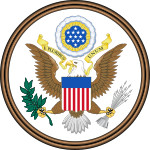US Government

|
|
| Formation | 1789 |
|---|---|
| Founding document | United States Constitution |
| Jurisdiction | United States of America |
| Website | www |
| Legislative branch | |
| Legislature | Congress |
| Meeting place | Capitol |
| Executive branch | |
| Leader | President of the United States |
| Appointer | Electoral College |
| Headquarters | The White House |
| Main organ | Cabinet |
| Departments | 15 |
| Judicial branch | |
| Court | Supreme Court |
| Seat | Washington, D.C. |
The Federal Government of the United States is the federal government of the United States, a republic in North America, composed of 50 states, one district, Washington, D.C. (the nation's capital), and several territories. The federal government is composed of three distinct branches: legislative, executive, and judicial, whose powers are vested by the U.S. Constitution in the Congress, the President, and the federal courts, including the Supreme Court, respectively. The powers and duties of these branches are further defined by acts of Congress, including the creation of executive departments and courts inferior to the Supreme Court.
The full name of the republic is "United States of America". No other name appears in the Constitution, and this is the name that appears on money, in treaties, and in legal cases to which it is a party (e.g. Charles T. Schenck v. United States). The terms "Government of the United States of America" or "United States Government" are often used in official documents to represent the federal government as distinct from the states collectively. In casual conversation or writing, the term "Federal Government" is often used, and the term "National Government" is sometimes used. The terms "Federal" and "National" in government agency or program names generally indicate affiliation with the federal government (e.g. Federal Bureau of Investigation, National Oceanic and Atmospheric Administration, etc.). Because the seat of government is in Washington, D.C., "Washington" is commonly used as a metonym for the federal government.
...
Wikipedia
